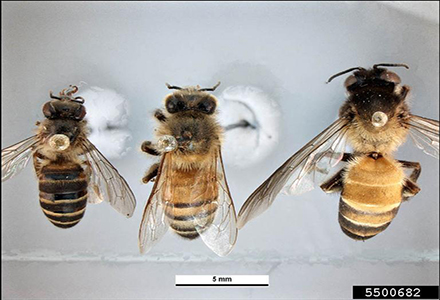PLANT PEST

Ken Walker, Museum Victoria, PaDIL.
Bees (Apis spp.) (exotic species)
Exotic to Australia, Asian honey bee under management around Cairns
Features: A number of bee species (Apis spp.) from overseas that could disrupt honey bees and bring bee diseases and parasites
Where they're from: Asia, Africa, Middle East, North and South America
How they spread: Bees can stow away on ships, boats and the cargo and containers they carry
At risk: Australia’s honey bees and the crops that they pollinate
Africanised honeybee and cape honeybee are listed on both the National Priority Plant Pests and the National Priority List of Exotic Environmental Pests, Weeds and Diseases as they have the potential for significant plant industry/agriculture impacts and may also cause significant damage to our environment and social amenity.
Keep it out
Exotic bee species are a threat to the healthy populations of European honey bees we have in Australia, and could also cause damage to Australian native species of pollinators.
Swarms of exotic bees can bring mites or other pests and diseases that could damage our healthy colonies. They are poor at producing honey and some are aggressive, robbing honey from European honey bees and taking over their hives.
Protecting the health of Australia’s honey bees is a key biosecurity priority because as well as honey and other bee products, many crops rely on bees for pollination. Exotic bee species and the diseases and parasites they could bring therefore put many fruiting crops at risk.
Australia has an active biosecurity partnership funded by government and industries, including crop industries, to protect our bees. The National Bee Pest Surveillance Program is one component of bee biosecurity activities. It operates at ports around Australia to quickly find any swarms of bees that have stowed away on ships and come ashore.
Importing goods
To keep exotic bees out of Australia, never ignore Australia’s strict biosecurity rules.
Import shipments may need to be treated and certified, so before you import, check our Biosecurity Import Conditions system (BICON).
What to look for
Bees can arrive on imported goods, including vehicles and machinery, and on the conveyances and containers they come in. Often whole swarms will stow away.
It can be hard to distinguish exotic species from Australia’s existing bees, so any signs of bees entering Australia should be reported.
The key exotic species that pose a risk to Australia are:
Asian honey bees (Apis cerana):
- originated in Indonesia, and are now established in northern Queensland around Cairns
- are smaller and less hairy than European honey bees, with more pronounced black and yellow stripes
- are often infested with varroa mites, or bee diseases that could harm Australia’s existing honey bee colonies or native bees.
Giant honey bees (Apis dorsata):
- are larger than European honey bees, up to 2cm long
- originally from South East Asia
- prefer tropical climates.
Red dwarf honey bees (Apis florea):
- are smaller than European honey bees
- have distinctive red-brown, white and black bands on the abdomen
- have nests that are a single comb, usually less than 25cm across
- can carry exotic mites or diseases
- rob honey from the hives of European honey bees.
Cape honey bees (Apis mellifera capensis):
- are found only in South Africa
- look much the same as the European honey bees we have in Australia
- are not good at producing honey
- take over the hives of other bees.
Africanised honey bees (Apis mellifera scutellata):
- originally from sub-Saharan Africa
- look much the same as the European honey bees we have in Australia
- are highly aggressive, attacking animals or humans if nests are disturbed.
Africanised honey bees (Apis mellifera scutellata hybrids):
- are hybrids of European honey bee and African honey bees
- look much the same as the European honey bees we have in Australia
- are much more aggressive
- could breed with honey bees making our bees more aggressive.
Where to look
Importers
If you work around imported goods you need to look for swarms of bees or their hives attached to:
- vessels
- shipping containers
- conveyances (vehicles, machinery and infrastructure components).
Beekeepers
Check your hives frequently, keeping an eye out for exotic invaders or any signs of diseased bees.
BeeAware has resources to help you manage your hives as well as details of pest bees and bee pests.
People who live near ports
All Australians should keep an eye out for and report any bees or swarms that they don’t recognise, especially if you live near a port.

What to do
If you think you’ve found exotic bees:
- take a photo
- contain them without disturbing them if you can (this may be as simple as closing the doors on a shipping container).
